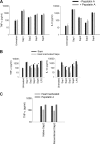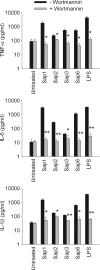The Inflammatory response induced by aspartic proteases of Candida albicans is independent of proteolytic activity
- PMID: 20713630
- PMCID: PMC2976325
- DOI: 10.1128/IAI.00789-10
The Inflammatory response induced by aspartic proteases of Candida albicans is independent of proteolytic activity
Abstract
The secretion of aspartic proteases (Saps) has long been recognized as a virulence-associated trait of the pathogenic yeast Candida albicans. In this study, we report that different recombinant Saps, including Sap1, Sap2, Sap3, and Sap6, have differing abilities to induce secretion of proinflammatory cytokines by human monocytes. In particular Sap1, Sap2, and Sap6 significantly induced interleukin-1β (IL-1β), tumor necrosis factor alpha (TNF-α), and IL-6 production. Sap3 was able to stimulate the secretion of IL-1β and TNF-α. All Saps tested were able to induce Ca(2+) influx in monocytes. Treatment of these Saps with pepstatin A did not have any effect on cytokine secretion, indicating that their stimulatory potential was independent from their proteolytic activity. The capacity of Saps to induce inflammatory cytokine production was also independent from protease-activated receptor (PAR) activation and from the optimal pH for individual Sap activity. The interaction of Saps with monocytes induced Akt activation and phosphorylation of IκBα, which mediates translocation of NF-κB into the nucleus. Overall, these results suggest that individual Sap proteins can induce an inflammatory response and that this phenomenon is independent from the pH of a specific host niche and from Sap enzymatic activity. The inflammatory response is partially dependent on Sap denaturation and is triggered by the Akt/NF-κB activation pathway. Our data suggest a novel, activity-independent aspect of Saps during interactions of C. albicans with the host.
Figures





Similar articles
-
Secretory Aspartyl Proteinases Cause Vaginitis and Can Mediate Vaginitis Caused by Candida albicans in Mice.mBio. 2015 Jun 2;6(3):e00724. doi: 10.1128/mBio.00724-15. mBio. 2015. PMID: 26037125 Free PMC article.
-
Candida albicans-secreted aspartic proteinases modify the epithelial cytokine response in an in vitro model of vaginal candidiasis.Infect Immun. 2005 May;73(5):2758-65. doi: 10.1128/IAI.73.5.2758-2765.2005. Infect Immun. 2005. PMID: 15845479 Free PMC article.
-
Secreted aspartic proteases of Candida albicans activate the NLRP3 inflammasome.Eur J Immunol. 2013 Mar;43(3):679-92. doi: 10.1002/eji.201242691. Epub 2013 Jan 31. Eur J Immunol. 2013. PMID: 23280543
-
Contribution of Aspartic Proteases in Candida Virulence. Protease Inhibitors against Candida Infections.Curr Protein Pept Sci. 2017;18(10):1050-1062. doi: 10.2174/1389203717666160809155749. Curr Protein Pept Sci. 2017. PMID: 27514853 Review.
-
Candida albicans secreted aspartyl proteinases.Curr Top Med Mycol. 1996 Dec;7(1):55-69. Curr Top Med Mycol. 1996. PMID: 9504059 Review.
Cited by
-
Distinct roles of Candida albicans-specific genes in host-pathogen interactions.Eukaryot Cell. 2014 Aug;13(8):977-89. doi: 10.1128/EC.00051-14. Epub 2014 Mar 7. Eukaryot Cell. 2014. PMID: 24610660 Free PMC article.
-
Novel Aggregation Properties of Candida albicans Secreted Aspartyl Proteinase Sap6 Mediate Virulence in Oral Candidiasis.Infect Immun. 2015 Jul;83(7):2614-26. doi: 10.1128/IAI.00282-15. Infect Immun. 2015. PMID: 25870228 Free PMC article.
-
Functional Characterization of Secreted Aspartyl Proteases in Candida parapsilosis.mSphere. 2019 Aug 21;4(4):e00484-19. doi: 10.1128/mSphere.00484-19. mSphere. 2019. PMID: 31434748 Free PMC article.
-
Paracoccidioides brasiliensis induces cytokine secretion in epithelial cells in a protease-activated receptor-dependent (PAR) manner.Med Microbiol Immunol. 2017 Apr;206(2):149-156. doi: 10.1007/s00430-016-0490-x. Epub 2016 Dec 19. Med Microbiol Immunol. 2017. PMID: 27995367
-
In vivo induction of neutrophil chemotaxis by secretory aspartyl proteinases of Candida albicans.Virulence. 2016 Oct 2;7(7):819-25. doi: 10.1080/21505594.2016.1184385. Epub 2016 Apr 29. Virulence. 2016. PMID: 27127904 Free PMC article.
References
-
- Albrecht, A., A. Felk, I. Pichova, J. R. Naglik, M. Schaller, P. de Groot, D. Maccallum, F. C. Odds, W. Schafer, F. Klis, M. Monod, and B. Hube. 2006. Glycosylphosphatidylinositol-anchored proteases of Candida albicans target proteins necessary for both cellular processes and host-pathogen interactions. J. Biol. Chem. 281:688-694. - PubMed
-
- Borelli, C., E. Ruge, J. H. Lee, M. Schaller, A. Vogelsang, M. Monod, H. C. Korting, R. Huber, and K. Maskos. 2008. X-ray structures of Sap1 and Sap5: structural comparison of the secreted aspartic proteinases from Candida albicans. Proteins 72:1308-1319. - PubMed
-
- Borg-von Zepelin, M., S. Beggah, K. Boggian, D. Sanglard, and M. Monod. 1998. The expression of the secreted aspartyl proteinases Sap4 to Sap6 from Candida albicans in murine macrophages. Mol. Microbiol. 28:543-554. - PubMed
-
- Brunke, S., and B. Hube. 2006. MfLIP1, a gene encoding an extracellular lipase of the lipid-dependent fungus Malassezia furfur. Microbiology 152:547-554. - PubMed
-
- Calderone, R. A., and W. A. Fonzi. 2001. Virulence factors of Candida albicans. Trends Microbiol. 9:327-335. - PubMed
Publication types
MeSH terms
Substances
LinkOut - more resources
Full Text Sources
Other Literature Sources
Molecular Biology Databases
Miscellaneous

